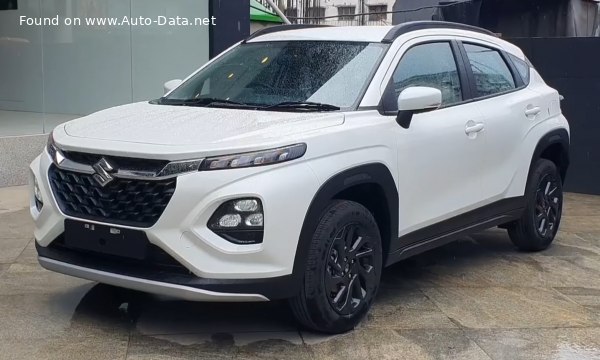


| What is the body type, Suzuki Fronx? | SUV, 5 Doors, 5 Seats |
|---|---|
| How much power, Suzuki Fronx SUV 2023 1.0 Turbo Boosterjet (100 Hp) Mild Hybrid Automatic? | 100 Hp, 148 Nm 109.16 lb.-ft. |
| What is the engine size, Suzuki Fronx SUV 2023 1.0 Turbo Boosterjet (100 Hp) Mild Hybrid Automatic? | 1.0 l 998 cm3 60.9 cu. in. |
| How many cylinders, 2023 Suzuki 1.0 Turbo Boosterjet (100 Hp) Mild Hybrid Automatic? | 3, Inline |
| What is the drivetrain, Suzuki Fronx SUV 2023 1.0 Turbo Boosterjet (100 Hp) Mild Hybrid Automatic? | Front wheel drive. MHEV (Mild Hybrid Electric Vehicle, power-assist hybrid, battery-assisted hybrid vehicles, BAHV). The Internal combustion engine (ICE) and electric motor drive the front wheels of the car with the ability to work only in mixed mode. |
| How long is this vehicle, 2023 Suzuki Fronx SUV? | 3995 mm 157.28 in. |
| How wide is the vehicle, 2023 Suzuki Fronx SUV? | 1765 mm 69.49 in. |
| What is the curb weight, 2023 Suzuki Fronx 1.0 Turbo Boosterjet (100 Hp) Mild Hybrid Automatic? | 1055-1060 kg 2325.88 - 2336.9 lbs. |
| What is the gross weight, 2023 Suzuki Fronx 1.0 Turbo Boosterjet (100 Hp) Mild Hybrid Automatic? | 1480 kg 3262.84 lbs. |
| How much trunk (boot) space, 2023 Suzuki Fronx SUV? | 308 l 10.88 cu. ft. |
| How many gears, What type is the gearbox, 2023 Suzuki Fronx 1.0 Turbo Boosterjet (100 Hp) Mild Hybrid Automatic? | 6, automatic transmission |
| General information | |
|---|---|
| Brand | Suzuki |
| Model | Fronx |
| Generation | Fronx |
| Modification (Engine) | 1.0 Turbo Boosterjet (100 Hp) Mild Hybrid Automatic |
| Start of production | 2023 year |
| Powertrain Architecture | MHEV (Mild Hybrid Electric Vehicle, power-assist hybrid, battery-assisted hybrid vehicles, BAHV) |
| Body type | SUV |
| Seats | 5 |
| Doors | 5 |
| Performance specs | |
| Fuel Type | Petrol (Gasoline) |
| Weight-to-power ratio | 10.6 kg/Hp, 94.8 Hp/tonne |
| Weight-to-torque ratio | 7.1 kg/Nm, 140.3 Nm/tonne |
| Electric cars and hybrids specs | |
| Battery voltage | 48 V |
| Battery technology | Lithium-ion (Li-Ion) |
| Internal combustion engine specs | |
| Power | 100 Hp @ 5500 rpm. |
| Power per litre | 100.2 Hp/l |
| Torque | 148 Nm @ 2000-4500 rpm. 109.16 lb.-ft. @ 2000-4500 rpm. |
| Engine layout | Front, Transverse |
| Engine Model/Code | Boosterjet / K10C |
| Engine displacement | 998 cm3 60.9 cu. in. |
| Number of cylinders | 3 |
| Engine configuration | Inline |
| Number of valves per cylinder | 4 |
| Fuel injection system | Direct injection |
| Engine aspiration | Turbocharger, Intercooler |
| Engine oil capacity | 3.5 l 3.7 US qt | 3.08 UK qt |
| Engine oil specification |  Log in to see. Log in to see. |
| Engine systems | Start & Stop System |
| Space, Volume and weights | |
| Kerb Weight | 1055-1060 kg 2325.88 - 2336.9 lbs. |
| Max. weight | 1480 kg 3262.84 lbs. |
| Max load | 420-425 kg 925.94 - 936.96 lbs. |
| Trunk (boot) space - minimum | 308 l 10.88 cu. ft. |
| Fuel tank capacity | 37 l 9.77 US gal | 8.14 UK gal |
| Dimensions | |
| Length | 3995 mm 157.28 in. |
| Width | 1765 mm 69.49 in. |
| Height | 1550 mm 61.02 in. |
| Wheelbase | 2520 mm 99.21 in. |
| Minimum turning circle (turning diameter) | 9.8 m 32.15 ft. |
| Drivetrain, brakes and suspension specs | |
| Drivetrain Architecture | The Internal combustion engine (ICE) and electric motor drive the front wheels of the car with the ability to work only in mixed mode. |
| Drive wheel | Front wheel drive |
| Number of gears and type of gearbox | 6 gears, automatic transmission |
| Front suspension | Independent type McPherson |
| Rear suspension | Torsion |
| Front brakes | Disc |
| Rear brakes | Drum |
| Assisting systems | ABS (Anti-lock braking system) |
| Steering type | Steering rack and pinion |
| Power steering | Electric Steering |
| Tires size | 195/60 R16 |
| Wheel rims size | 16 |